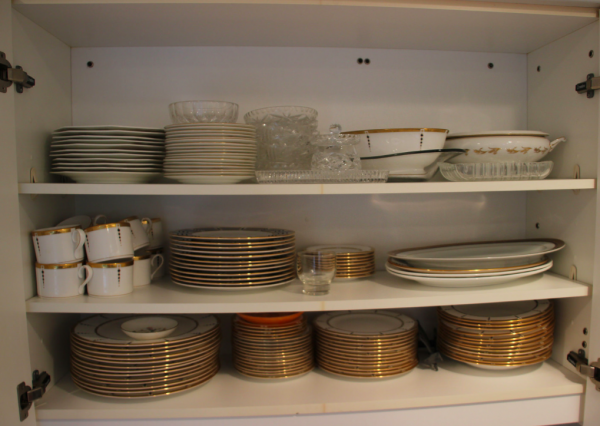With rare exceptions, you’re going to get 10 to 30 cents on the dollar for all that stuff you think is valuable.
Here is a reality that has been hard for my clients to wrap their heads around: Generation Y, Z, and Millennials don’t want anything to do with china, silver, candlelabras, “limited edition” anything, Lladros, Hummels, collectibles from the Franklin Mint, china cabinets, entertainment units, steamer trunks, and a whole raft of other things. Steuben, Henredon, Waterford? Blank stares. Crystal, or mahogany furniture? Forget about it!
The sad truth is that much of what my clients wish to discard when they downsize is unwanted by charities (which are now inundated with similar merchandise), “antique” dealers, or even their own adult children. A lot of what was once sought after cannot be sold, much less given away.
Old and Out of Vogue
Recently, 3,000 Millennials were asked to name a furniture or china brand, and La-Z-Boy and Ikea didn’t count. Results? 0.3% could. Sentimental as we may be about our precious collectibles, we need to face the fact that, unless the pendulum of personal tastes swings wildly in the opposite direction again, they are never going command high resale prices.
The world has changed. Just try asking a young couple starting a new home if they’d like three sets of your unwanted china, your 500-volume book collection, an armoire, or a pair of somber, dark brown cabinets. How about “no?”
Younger people invest in experiences, not stuff. However, anyone born before 1970 was steeped in the culture of acquisition. They were sold that idea by marketers and advertisers for decades. Post-WWII and Boomers were the most acquisitive generations in recorded history. So what are we to do with closets full of table linen, breakfronts full of assorted odd bone china cups, living rooms full of 19th century reproductions of 18th century furniture, or stacks of magazines and newspapers featuring Neil Armstrong landing on the moon?
Here’s the low-down, based on my experience, on some of what’s almost worthless—and some of what actually has fair to fabulous monetary value.
Books: Almost Always Worthless
People tend to think that 20th century first editions are worth something, but in reality they have next to no value. Neither do entire sets of encyclopedias, Nancy Drews, or the Hardy Boys. Libraries, schools, and other institutions do not want your books. Places like The Strand pay a few dollars per linear foot, but you need to box and get the books to them.
There are exceptions. For example: limited editions such as art books with original lithographs; rare books and illuminated entire manuscripts; and unusual, out-of-print (and sometimes decidedly un-P.C.) titles such as Little Black Sambo. These do fetch a very good price.
China: Pennies on the Dollar
Today, china can be bought for 25 cents per piece—and we’re talking high quality, good condition pieces, not junk. I can barely give china or crystal away. A complete set of 12 place settings in a desirable pattern (not Lenox gold-banded off-white, which no one wants) would bring $1+ per piece. If you value your own china, there are places where you can replace a broken or chipped plate so you will still have a full set. Try Replacements or eBay. These vendors charge a steep premium for people in need of a plate, but they pay pennies to the sellers. One needed piece is worth more than it originally cost.
Silver: It Depends
Most silver plate has next to no value whatsoever. Exceptions would include fine old English Sheffield silver plate and other equivalent plate.
Sterling silver is very inexpensive today, and used sterling pieces are regularly sold by weight. Monogrammed sterling has less value than non-monogrammed. Exceptions for sterling would include George Jensen mid-century modern sterling flatware and Gorham Martelé Sterling pieces (Martelé is a limited, hand wrought production line of 950 sterling that was made from 1896 through the 1930’s). Other hallmark sterling that is very rare and extraordinary is still desirable and does bring excellent money, but very few people actually own any of it.
Gold, Coins & Stamps: Face Value and Weight
Stamps: Have a stamp collection you started as a child with albums and stamps from the U.S. Postal Service? You are now approaching your 85th birthday? Do you or your adult children assume you are sitting on a fortune? Actually, you’re sitting on something you can lick and stick to the letters you mail. Most stamps are worth their face value and that’s it. Real collectors and dealers do exist and their stamps are rare and valuable. If you are that type of collector you know what you have.
Coin Collections: Some Indian Head pennies are worth a fortune. There was a time when dollars, half dollars, quarters, and dimes coins had a 90% silver content. These are worth more than face value. Some are worth a lot more. To determine if your coins fall into this category, line them up in the palm of your hand as if you were holding a roll of quarters. If you see little brown (copper) lines on the edges of the coin, you’re looking at face value. If they don’t have a little brown line, they are worth more. If they are rare, they are worth a lot more. Of course condition goes hand in glove with value. After 1967, coins were minted with less silver.
Gold Coins: Pre-1933 gold coins have historical significance, and many are worth quite a bit more than gold weight. (USA gold coins were first issued in 1795.) Coins minted through the early 1800s are the most valuable and desirable. Values depend upon year, condition, and where minted. Late 1800s and 1900s $20 gold coins are literally worth their weight in gold plus some. There was a time when framing a gold coin and hanging it from a gold chain was thought of as a cool piece of jewelry. That frame, however, limited the value, making the entire necklace worth its weight in gold—period. Much like stamps, if you have something really rare you’d likely already know it. However, never assume. It pays to find out what is hidden in the box that Grandpa squirreled away for years in the top drawer of his bureau.
Diamonds: Small, Colorful, and Rare Will Command Money
There was a time when perfect 1 carat diamonds were the currency of the day, but no longer. There is a market for wonderful quality diamonds larger than 2.5 carats. Size does matter. For example, and when it comes to value, there is a vast difference in money between a 3.8 carat versus a 4 carat. It’s interesting how such a small differential in size can result in such a large dollar gap. Savvy diamond buyers/collectors seek and pay top dollar for small, perfect, and highly-prized stones in rare colors such as purple and orange. In fact, a 3/4 carat pure orange diamond is worth more than a pure white 5 carat diamond. Regardless, diamonds must come with a GIA certificate from the Gemology Institute of America. The buyer needs to know that the stone was not heat-treated to enhance color.
Native American Works: You Need Documentation
Native American artifacts include fetishes, baskets, pottery, etc. The value of the items is highly dependent upon the artist who made it and/or its provenance back to the days before works were signed or attributed to an individual versus a tribe. You need to know where the piece came from, when you got it, and who (if anyone known) made it. People who collect this type of craft need to hold onto their receipts, as very few really old authentic pieces have markings that are identifiable.
Jewelry: Brand Names Are Worth More
Jewelry is often worth no more than its weight in silver or gold, unless you have a signed piece. Some examples are: a bracelet by a well-known Zuni silversmith, signed and traced to its designer, or jewelry from well-known brand names such Tiffany, Cartier, Bulgari, etc. These stamped and/or signed pieces will command higher prices. There is much more to be learned about reselling jewelry, but this is a good beginning.
Art: If You Get Lucky, You Could Get Rich
There are true collectors who scour the world for extraordinary pieces of art, but most of us are not among them. Some lucky individuals have had the good fortune to buy works of art from starving artists who have since died and then became famous. Jane Freilicher, a Long Island painter of floral scenes and marshes who passed away in 2014, is an example of an artist who subsequently became well-known. Her paintings originally sold for approximately $500, but are now worth $35,000+ per painting. My advice? Buy it because you like to look at it, not because you think it will be worth a fortune one day. Additionally, originals are worth more than lithographs and many lithographs are simply decorative and have little resale value.
Hermés Handbags: Worth a Fortune
This is indeed a special category! As absurd as it sounds, Hermés handbags are worth a fortune. They are the uber status symbol at present. You have to have extremely prominent social status to even get into the queue to acquire one from Hermés. There will be a steep markup tacked on if you buy one from a reseller. As a reseller, you can make a wonderful profit.
Seller Beware!
When you are a one-off seller, be aware that whoever is buying is most likely going to take advantage of you. They are never going to see you again. As the British like to say, you “have a feeling in your water” that you are being ripped off, but you do not know what else to do. I guess this is the perfect place for me to say, “Call me.”
Some Advice
Whatever you are selling, get as high up in the food chain as possible to maximize your return. Don’t start at the lower levels; e.g. the corner jewelry store that buys your unwanted jewelry, or a pawnbroker. They resell to another dealer who resells it yet again, until someone gets to the smelter or the high-end reseller. You could make a lot more money, even by paying a professional a commission.
Many sellers look online in an effort to understand what values are for comparable items. When you check e-Bay and First Dibbs, look at actual sales results; the asking prices are not reality. Similar items being sold in antiques shops are priced at full retail numbers that factor in rents, overhead etc. Remember, you are not a retailer.
In the end, it’s not always about reaping a fortune. If you recoup 10, 50, or 100 dollars for something you have used, loved, and no longer want, it’s found money. Someone has paid you and you did not need to pay the trash removal person to take it away.
Instead of getting pennies on the dollar for a beautiful china set that you rarely if ever use, why not start using it and live like a lady/gentleman? Enjoy your finest things, or make some grocery money and make a new owner happy at the same time.
While I am not a licensed appraiser, I have learned quite a lot over the years. Experience is a wonderful teacher. As always, if you have questions, I’m happy to answer them.
Best wishes,
Sharon
646-784-3073
www.360demenager.com
Subscribe to Receive My Newsletter:
Note: Part of this post was contributed by a NASSM member.



Sharon could not be more “right on”. As an appraiser, I constantly have to deliver this bad news to clients. I an sure I will be sharing this article time and again!